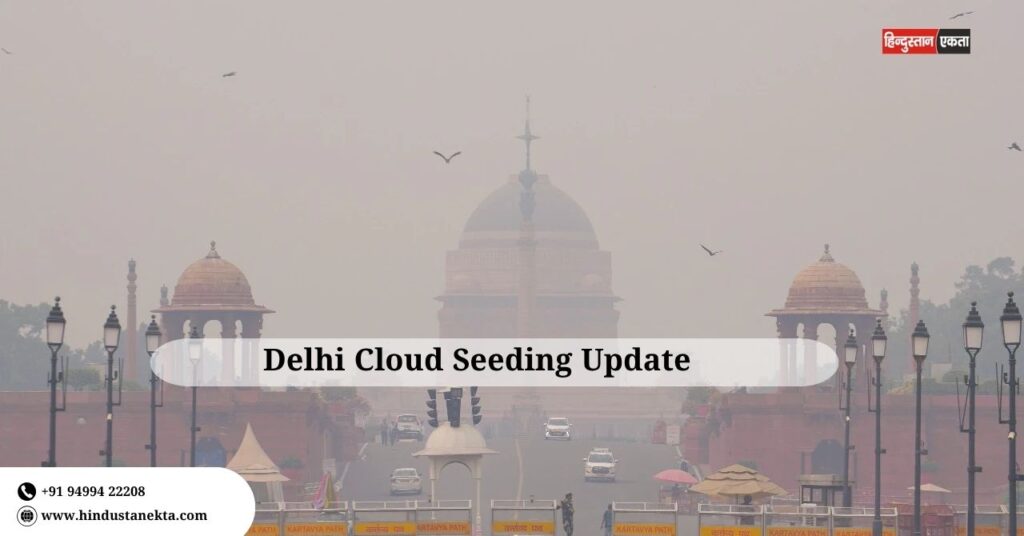The latest Delhi Cloud Seeding Update highlights the Delhi government’s bold move to use artificial rain to fight severe air pollution. With air quality dipping into the “very poor” zone, authorities have turned to cloud-seeding programs as a new hope. This blog explains what the Delhi Cloud Seeding Update means, why it matters, and what lies ahead.
What is the Delhi Cloud Seeding Update?
The Delhi Cloud Seeding Update refers to recent trials by the Delhi government and IIT Kanpur to trigger artificial rainfall for reducing pollution. On October 28, 2025, aircraft released cloud-seeding materials to promote precipitation and wash out pollutants.
According to reports, the operation is still experimental, and early results show only limited success due to unfavorable weather conditions.
How Cloud Seeding Works
The Science Behind It
Cloud seeding involves dispersing tiny particles like silver iodide or salt into clouds to encourage condensation and rainfall. If successful, the rain can clean the air by settling suspended dust and pollutants.
Why Delhi Opted for It
Delhi’s pollution worsens every winter due to vehicle emissions, industrial smoke, crop burning, and stagnant air. The Delhi Cloud Seeding Update reflects the city’s attempt to create rainfall artificially when natural rain is scarce.
Key Insights from the Delhi Cloud Seeding Update
Limited Feasibility
The Delhi Cloud Seeding Update shows that Delhi’s winter atmosphere isn’t ideal for consistent cloud formation. Moisture levels are often too low, and shallow clouds make seeding difficult. Even successful rainfall would provide relief for only 1–3 days.
Cost and Results
Initial trials cost around ₹60 lakh but produced little measurable rain. Experts from IIT Delhi and IMD warned that such efforts may not be cost-effective. The Delhi Cloud Seeding Update indicates that future trials will depend on favorable weather and further scientific review.
Political and Expert Opinions
The trials have sparked debate. Some critics call the move a “gimmick,” while government officials defend it as a research-driven step to explore all options for cleaner air.
What the Delhi Cloud Seeding Update Means for Pollution Control
Temporary Relief Only
The Delhi Cloud Seeding Update confirms that artificial rain is not a permanent solution. It can reduce smog briefly but won’t solve the root problem — emissions.
Long-Term Measures Needed
To achieve lasting air-quality improvement, Delhi needs stronger emission-control policies, cleaner fuels, and strict industrial monitoring. Cloud seeding should only be viewed as a temporary emergency measure.
Evaluating Cost vs Benefit
Given the high cost and low success rate, experts suggest prioritizing investments in electric vehicles, green energy, and air-quality infrastructure over expensive cloud-seeding experiments.
The Future of the Delhi Cloud Seeding Update
More Trials Expected
Authorities plan to continue data collection and test future feasibility. The Delhi Cloud Seeding Update indicates upcoming studies with IIT Kanpur to refine techniques and timing.
Focus on Real Solutions
Alongside cloud seeding, Delhi must:
-
Enforce stricter vehicle-emission rules
-
Control construction dust
-
Stop stubble burning with better alternatives
-
Promote electric mobility and green public transport
Conclusion
The Delhi Cloud Seeding Update reflects a bold but experimental step toward cleaner skies. While artificial rain can temporarily reduce pollution, it is not a long-term fix. Real progress depends on cutting emissions and adopting sustainable practices.
Delhi’s cloud-seeding efforts mark the beginning of scientific innovation in pollution control, but the journey to clear skies still relies on persistent policy action and public cooperation.



